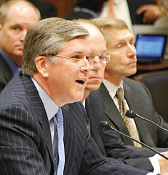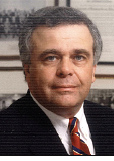Broadcasters Ready to Fight
WASHINGTON
"It's clear that they're gunning to shut down broadcasting," said Mark Aitken of Sinclair Broadcasting, the day after Federal Communications Commission Chairman Julius Genachowski appointed a special advisor to evaluate how broadcast TV spectrum should be reallocated.
Aitken, director of advanced technology for Sinclair urges the industry to "approach this problem with an 'outside-the-Beltway' mentality." Aitken cites the modulation battle of the 1990s and predicts, "We can beat this thing," through a coordinated response to the FCC's blitz assault on the airwaves.
Perry Sook, chairman/president/CEO of Nexstar Broadcasting Group, is even more adamant about the so-called "spectrum grab."
Citing the "unfunded Federal mandate" under which broadcasters spent $15 billion for the digital TV transition, Sook rattles off a roster of reasons why the FCC's dream for redistributing TV spectrum makes no sense.

NAB President Gordon Smith testifies at a House Subcommittee hearing on spectrum use last month. "Downconverting our spectrum to allow only a single standard definition channel would constitute one of the largest bait and switch schemes on consumers in the history of our country!" Sook said, inserting his own exclamation mark.
He also challenges the "philosophical argument," wondering why the "iPhone is entitled to more spectrum than local broadcasters."
"I don't know that there is a public interest mandate for Apple," he said. "Compare that to the public service and educational requirements placed on broadcasters for our use of the spectrum."
Sook suggests that the FCC has overstepped its bounds.
"Congress allocated the spectrum to broadcasters and even imposed a 5 percent tax levy on revenues derived from ancillary uses," he said. "The process is working exactly as Congress has intended and... the FCC has no authority to suggest, much less attempt to orchestrate, a potential reclamation of broadcast spectrum."
LIGHTING THE FUSE
Aitken and Sook are on the front lines in the expanding Washington debate about how to use the airwaves in today's demanding wireless world. A rapid series of events has escalated the battle and promises to extend the skirmishes beyond the pending FCC rulemaking into a drawn-out Congressional and eventual court confrontation.
The spectrum allocation tinderbox was lit by a Consumer Electronics Association-funded study, released in late October, which suggested that $1 trillion of broadband services could be generated from the 300 MHz of spectrum used by TV broadcasters. The CEA study suggested that the broadcast bandwidth is now worth about $62 billion, and it included a proposal for carving out swaths of TV spectrum for other uses: mostly ones for wireless/mobile broadband applications.
Shortly afterwards, CEA and CTIA: The Wireless Association (formerly known as the Cellular Telephone Association) asked the FCC to examine reallocation of broadcast spectrum to prepare for the "looming spectrum crisis." They cited Congress's directive that the FCC must conduct an inventory of all available spectrum with recommendations for greater efficiency.
The FCC, which is in the midst of developing its National Broadband Plan—due in mid-February—jumped into the fray when the FCC's "Broadband Czar" Blair Levin, in a speech about a month later, supported the TV spectrum reallocation concept.
In early December, the commission issued an urgent request for additional data from broadcasters, citing a "concern that the United States will not have spectrum sufficient to meet the demand for wireless broadband services in the near future."
The wording of the FCC "data request" triggered even greater fears, exacerbated by the FCC's unusually short three-week turnaround period. In its official notice, the commission explained that its "inquiry takes into account the value that the United States puts on free, over-the-air television, while also exploring market-based mechanisms for television broadcasters to contribute to the broadband effort any spectrum in excess of that which they need to meet their public interest obligations and remain financially viable."
For many broadcasters, that sounded like a threat to reduce TV bandwidth to standard-definition capacity and eliminate ancillary channel bandwidth.
Meanwhile on Capitol Hill, a couple of bills emerged, adding to the threats to the industry. The Spectrum Relocation Improvement Act of 2009 (H.R. 3019) and the Radio Spectrum Inventory Act (H.R. 3125) bubbled up in summer and autumn and were greeted as "incentives for efficient spectrum utilization" in the words of Rep. Henry Waxman (D-Calif.). At Telecommunications Subcommittee hearings in December, Waxman, who chairs the House Energy and Commerce Committee, described the bills as means to "enhance our ability to develop forward-looking spectrum policies" and the start of a process "to examine whether there is under-utilized spectrum."
EXPANDING THE BATTLE
As the debate escalates, technology companies and their advocates are building support for their viewpoint that Americans—including military and public agencies such as first responders—will need evermore wireless capacity to conduct their work. Broadcasters are marshalling their forces to take on the assault.

Mark Aitken, director, advanced technology, Sinclair "We are taking this threat to free over-the-air television very seriously," said David Donovan, president of the Association for Maximum Service Television (MSTV). He says that his members are "somewhat stunned" by the effort to grab broadcasters' airwaves.
"The Obama administration made a commitment to over-the-air digital television earlier this year when it delayed the DTV transition in order to help consumers maintain access to DTV," Donovan said. "FCC officials, along with just about every member of Congress, told the American Consumer that, if they bought a digital television or invested in a DTV converter box, they would be able to receive for free additional multiple program channels and/or HDTV programs."
Donovan contends that the "broadband task force [is] now reneging on this promise" less than six months later, adding that if the FCC's visions are realized, "The digital divide between rich and poor will become a canyon.
"It is entirely possible that high-definition TV will become the exclusive province of premium tier pay services," Donovan continued. "Mobile broadcasting and additional digital channels may never be realized."
Even as the FCC began poring over the public and industry comments about its spectrum reallocation examination, expert viewpoints popped up. Thomas Hazlett, a former FCC chief economist in the early 1990s and a self-described "free marketer," posited that the FCC should require local broadcasters to pool their airwaves to create seven overlay licenses of 42 MHz each; then the FCC would auction off all seven licenses.
Under the Hazlett plan—and similar cash-for-spectrum proposals—broadcast licensees would take the funds and the government would find other customers for the bandwidth. Some of the revenue generated from the auctions would be used to supply limited cable or satellite connections to the homes (Hazlett estimates 10 million) that do not currently use such multichannel access. Hazlett estimates that the 10-year cost for such connections would be $3 billion (10 million households at $300 each), just a fraction of the spectrum auction receipts.
"The whole point," Hazlett told TV Technology "is to get the spectrum in the next three to four years" or the value "would be lost."
SPECTRUM DEMAND 'FREIGHT TRAIN'
Tom Wheeler, a former president of CTIA, and before that, president of the National Cable & Telecommunications Association and now a technology venture capitalist, warns that the spectrum policy discourse "seems to sidestep the potential for… a data brownout calamity." He cites the predicted 50 to 100-fold increase in the computing power of microchips as a reason for increased wireless spectrum capacity.
"The spectrum demand freight train is moving faster than the ability to provide for its rights-of-way," he said. "The consequences of such an imbalance are not good for the nation."
For his part, the FCC's Levin says, "the biggest challenge is actually causing an action to occur before the problem is actually manifest in the world." In response to TV Technology queries, Levin compared the spectrum planning process to "getting folks to focus on the levees in New Orleans before Katrina, or the problems Richard Clarke had getting folks to focus before 9/11."

David Donovan, president, MSTV At the December House hearings, Gordon Smith, the new president/CEO of NAB, emphasized that "broadcasting and broadband are not 'either/or' propositions as some have suggested." Smith also cited the DTV transition and the emergence of mobile DTV.
"A comprehensive, objective examination of spectrum allocation and usage is a worthwhile endeavor," he told Congress. "Such an analysis—if done forthrightly and without bias—will demonstrate that broadcasters continue to be effective custodians of our nation's airwaves. Many broadcast services have not been, and cannot be, efficiently replicated by broadband services."
Aitken sees the current spectrum reallocation debate as an offshoot of the white spaces issue, during which Silicon Valley and its technology allies began eyeing the broadcast bandwidth as prime wireless real estate. He thinks it was a way for technology companies to determine if "they were dealing with a chihuahua or a rottweiler" in taking on the broadcast industry.
"Not all spectrum is created equal," Aitken said. If technology "spectrum squatters," as he calls the upstart users, "think that spectrum is better than glass fiber, then they don't know engineering." Aitken expects that the next battles will focus on the ways in which the government can squeeze efficiencies out of the spectrum to satisfy private investment.
MSTV's Donovan offers a blunt reminder that the debate is just beginning.
"The recommendations of the [FCC broadband] Task Force is the first step in a long process," he said. "Nonetheless, it is important because it may frame the debate. At this point, it is far from clear whether the commissioners support any idea."
Noting that the FCC's current review "seems to turn the spectrum inventory process on its head," Donovan adds that the current evaluation needs a full technical inventory to determine if "wireless companies are actually using their current allotments."
"If the government is going to reclaim from anyone, it should conduct such an inventory and not rely on paper estimates that a particular service needs more spectrum."
That is likely not to be the last word on this proposal.
Get the TV Tech Newsletter
The professional video industry's #1 source for news, trends and product and tech information. Sign up below.
Gary Arlen, a contributor to Broadcasting & Cable, NextTV and TV Tech, is known for his visionary insights into the convergence of media + telecom + content + technology. His perspectives on public/tech policy, marketing and audience measurement have added to the value of his research and analyses of emerging interactive and broadband services. Gary was founder/editor/publisher of Interactivity Report, TeleServices Report and other influential newsletters; he was the long-time “curmudgeon” columnist for Multichannel News as well as a regular contributor to AdMap, Washington Technology and Telecommunications Reports; Gary writes regularly about trends and media/marketing for the Consumer Technology Association's i3 magazine plus several blogs.

